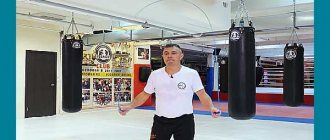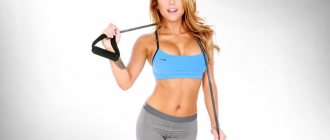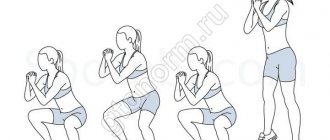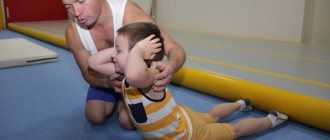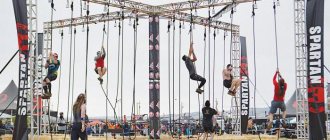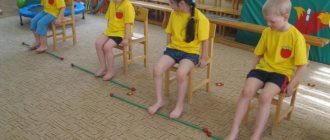Many people ask the question: how to learn to jump rope and do it correctly? Some people pick up a rope out of habit from childhood, athletes regularly use it in their training, and many want to lose weight, because jumping rope helps to lose weight.
First, you need to choose a rope and adjust it to its length. After the length is selected according to height, you can start jumping.
I’ll say right away: if you want to learn how to jump correctly , try not to make the mistakes that almost all beginners make.
Top 6 mistakes when jumping rope:
- Do not throw your arms over your shoulders before jumping. Correct starting position: the cord is behind, under the knees, arms slightly bent and brought forward.
- Don't jump on your entire foot. You need to jump on your toes, and landing on your toes is also mandatory.
- Don't bend your legs while jumping. Cushion when landing and straighten when pushing off.
- Avoid leaning forward or bending backward as this will cause you to lose your balance. Keep your back straight.
- Do not spread your arms wide away from your body - this will cause them to get tired quickly. The correct position of the arms during jumping is: elbows next to the body, slightly pulled back, hands slightly in front. Arms bent at elbows, relaxed.
- Don't hold your breath - you can't jump that long. You need to breathe evenly, at the same pace.
It may seem like there are too many restrictions, but once you have done a few workouts, nothing will be easier for you.
How to teach a child to jump
When buying a jumping simulator, parents should help their child master it. To teach children to jump, you need to follow a certain algorithm:
- First, you should get preschoolers interested in the game. Tell an interesting story about the appearance of the jump rope. Perhaps the preschooler himself will want to buy a jump rope and choose the exercise machine he likes in the store.
- Once the instrument is selected, you can let your child play with it. Then show with your example how to use it.
- You need to teach how to twist the rope not with your whole hand, but only with your hand. First with one, then with both hands.
- Learn to step over a skipping rope. Then, rising on your toes, roll over it onto your heels.
- Next, teach jumping correctly. Be sure to make sure that the child lowers himself onto his toes, then with his entire foot. Knees are bent.
- You need to jump on a mat; a hard floor can harm your feet. A carpet that is too thick will not work either.
The baby will definitely want to jump on his own if he masters the basic movements. You need to try to teach in a fun way so as not to discourage them. When teaching, do not rush your preschooler, master all the movements gradually.
Necessary skills for jumping rope.
To move on to jumping rope, you need to be able to jump on your toes, without bending your legs, at the same pace and throw the rope back and forth without jumping.
If there are no problems with this, let’s start studying the lead-in exercises .
- We throw the rope over, do a jump, and throw the rope over again so that the cord falls under our feet. This results in one full jump and two swings.
- Next we try to jump in a row. How many jumps should you jump per approach? When you are learning, count all the jumps and try to set another personal record - I advise you to always do this, no matter how much you jump. At first it will be 10 times, then 20, 30, 50 and 100.
- Try to learn to jump with different amplitudes - high and low jumps. For example, four jumps with a low jump and four with a high jump. Doing this exercise will help you gain better cord control, which in turn will make it easier to learn new techniques.
Ancient wisdom. The smoother you move, the faster you will learn everything. Sudden movements and jerks move you away from your goal.
We perform various tricks
Jumping rope can be not only useful, but also entertaining. A few interesting tricks will add variety to your activities and impress your friends. It can be:
- jumping in the other direction, backward;
- side elements;
- jumping over a double rope;
- group elements, when several people are involved in the exercise (“helicopter”).
The gymnastics rope rotates very quickly and can deliver strong blows, so you should start the exercise at a slow pace.
We invite you to familiarize yourself with various jumping rope tricks in the video:
Rotating the rope
To practice rotating the rope, take both handles in one hand and rotate them to your side. The hands work, and the forearms help a little, but the shoulders are turned off . This exercise allows you to train your right and left arms independently. To get an even better feel for the rope, it is useful to perform double jumps - this is when you jump twice in one revolution of the rope. We can say that these are “anti-double jumps.” To perform this exercise, you need to raise your arms higher at the moment when the cord is above your head, and thereby slow down the rotation. You can jump with a double jump not only forward, but also with a reverse rotation of the rope (jumping backwards)
Footwork in jumping rope on two legs
When you confidently master regular jumps, try moving on to different foot placement techniques :
- Apart-together
- Scissors (one leg forward, one leg back)
- Apart-cross
- Skier (two legs right-left)
- Bell (two legs back and forth)
- Twister (twisting the body in the pelvis)
First, we jump without a rope and teach the legs to obey, after that we add rotation with our arms. The main thing you need to pay attention to with different techniques for placing your legs is maintaining the tempo of jumping and the speed of rotation of the rope as with ordinary straight jumps. These exercises can be performed not only while rotating the rope forward, but also with reverse rotation, in a single jump or double jump. I talk in more detail about these and other jumping techniques, as well as lead-up exercises,
Those who have mastered jumping rope on two legs can move on, for example, start learning double jumps. And those who encounter difficulties are not always to blame for this; they are often let down by a jump rope that does not obey and gets confused when jumping. To prevent your mood from spoiling during training and to get faster, I recommend training with a beaded jump rope. This is the best thing that happens on the jump rope market - I recommend it to everyone. And now, after a short advertisement, we continue to learn how to jump.
Basic techniques
The first lesson is basic jumping on two legs.
Place your arms along your body and stand straight. Hold the rope at the level of your hips. Next, swing it and jump, pushing off with the balls of both feet. The knees are slightly bent. Make very low jumps, 5-10 centimeters is enough.
When you master the simplest technique, move on to the alternating technique. Start jumping, simply alternating your legs. Everything else is the same. It will be similar to simply stepping over a rope, but faster and with bounces.
Crisscross
The “cross” method cannot be called overly complicated. But it will still require some skill from you! When performing the exercise, alternate between jumping and classic jumping, but with your arms crossed in front of you.
In this case, you must, as it were, go through the loop into which the rope turns. This exercise perfectly trains your coordination of movements and also strengthens the vestibular system.
Double Jumps
The “double” method differs from the basic one only in that for one jump you will have to scroll your rope twice. There is no special life hack in this technique! You just have to spin your rope faster and jump higher.
This is quite difficult for beginners to do, so move on to this technique after thoroughly mastering the basic exercises. The process as a whole is much more intense, requiring more dedication and trained breathing.
The figure eight method
To do a figure eight jump, place your feet shoulder-width apart. Holding the rope with both hands, draw a figure eight in the air, with light and smooth movements, but across. First - from the right shoulder to the left hip. Then - from the left shoulder to the right hip.
At the same time, you should move your weight just as smoothly, from your right leg to your left, and vice versa, in time with the movement of your arms. Try doing the figure eight slowly at first to adjust the process. And do it with caution, because the jump rope can hurt!
Jumping rope or sprinting
Jumping rope is a type of jumping where you alternate landing on your right and left feet. In order to master this technique, you must first learn how to jump on one leg . Separately on the right and separately on the left. Jump four times on your right foot, then four jumps on your left, then again on your right, etc. Then two jumps on the right and two on the left. After this, you can change your leg for each jump - and now you are running. You can also run with high knees and shin overlapping.
When to start training
If at one or two years of age a child does not yet have enough control of his body to confidently jump to the rhythm of a spinning rope, then from the age of three you can begin to train jumping skills in group outdoor games.
It is important to choose tasks in accordance with the physical development and interests of the children. By the age of 5-7 years , a preschooler will be able to learn how to perform a set of simple individual exercises.
Conclusion : you can start preparatory classes as early as 2 years old, and hope for good coordination and a developed sense of balance by about 6 years old. The optimal age for the first targeted training with a jump rope is 4 years.
Heel-toe
This technique is performed in four counts (four rotations of the rope): 1. The heel of the right foot is brought forward, the body weight is on the left foot. 2. The toe of the right foot is brought back, the body weight is on the left foot. 3. The heel of the left foot is brought forward, the body weight is on the right foot. 4. The toe of the left foot is brought back, the body weight is on the right foot.
The heel-toe exercise can be complicated by double jumping and turning on the heel
How to choose clothes and a jump rope for classes
- Choosing a jump rope. The projectile must be selected based on the person’s height. To determine your ideal length, you need to stand with both feet in the middle of the rope and adjust its length so that its handles reach approximately the level of your chest or armpits.
- Choice of clothes and shoes. The ideal option would be a tracksuit or clothing that will not cause discomfort or put pressure on any part of the body. It is best to choose lightweight shoes with thin and comfortable soles.
Cancan
This technique is reminiscent of the famous French dance and is performed by successive raises of the knee bent and straight, alternating with jumps on two legs. A full circle is completed in 8 jumps.
I talk in more detail about footwork in jumping rope, as well as lead-up exercises and additional techniques in my video lesson - be sure to watch it.
Exercises
A set of exercises with a skipping rope:
- Raise the rope folded four times over your head, bending backwards and placing one foot to the side on your toes.
- Hold the rope folded four times down behind your back, bend forward, lowering your arms to the middle of your shins and do 3 bends with springs, try to touch your chest with your legs.
- Raise one leg in the air, pulling the jump rope with your foot, and hold for a few seconds, maintaining your balance.
- Lie on your back, pull the rope with straight legs and do rolls on your back.
- Jump rope in half squats and squats.
These exercises can be used as a preparatory complex when moving on to more complex movements with a skipping rope, which can be done to music. With schoolchildren, you can do a complex group performance, in which several children can jump over a skipping rope and do semi-acrobatic tricks with a skipping rope. If you take an integrated approach - combining gymnastics, acrobatics with jump rope exercises, you can create an interesting choreographic performance.
How long does it take to jump rope?
How long should you jump rope to learn how to do it efficiently and without mistakes? For everyone, this will be a different number, which depends on your preparation, what kind of sport you play and how motivated you are.
On average, I can recommend jumping three times a week for 20 minutes to an hour, gradually increasing the duration of the sessions. to warm up well before training and do stretching exercises . This will reduce the risk of injury and get you results faster.
What else to read: How to choose a jump rope. How to properly adjust a jump rope according to height. How to teach a child to jump rope. How to learn to double jump on a skipping rope.
I will be glad to see you in my jump rope store.
The benefits of jumping rope for children's health
It has long been clear to everyone that a jump rope is an excellent exercise machine for the body. Not only children, but also people of different professions use a jump rope, as it helps:
- Warm up before playing sports.
- Train and strengthen the muscles of the legs and arms.
- Become a strong, agile, resilient body.
- It is good to train the vestibular apparatus.
- Improve coordination of movements, balance, sense of rhythm.
- To develop attentiveness, observation, and visual acuity of children, since the game requires observation of rapid movement.
- The jump rope exercise machine helps the child develop an even posture.
Jumping is also an excellent cardio exercise. When jumping, the heart pumps blood faster, which improves physical condition. The calf muscles in your legs contract, helping the veins push blood toward the heart.
Important! The jump rope needs to be selected correctly according to height. To do this, stretch your arms forward with the rope folded in half. It should slightly reach the floor. If it is too long or short, it will be uncomfortable to practice.
How did the jump rope appear?
The jump rope appeared before the 19th century. Initially it was intended as a simulator for boys. Later, girls mastered it. According to the English version of its origin, people jumped over a leather cord during Easter games. According to the Chinese version, the jump rope originated from ordinary cords and ropes that were used in work. Children saw adults jumping over cords that were in their way. Later they started doing it themselves, turning it into a game.
